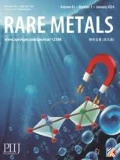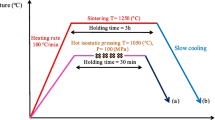Abstract
Thermohydrogen processing can enhance workability, decrease flow stress and deforming temperature of titanium alloys. In this study, thermohydrogen processing was carried out for metastable β-type TB8 alloy. The microstructures of hydrogenated TB8 alloy were investigated based on scanning electron microscopy (SEM), transmission electronic microscopy (TEM) as well as X-ray diffraction (XRD) analysis. The results reveal that δ hydride phase forms in the hydrogenated TB8 alloy, but the amount of β phase increases with hydrogen content increasing. Single β phase appears when the hydrogen content reaches 0.7 wt%. The alloying elements redistribute in the hydrogenated TB8 alloy, and hydrogen leads to the reduction of the alloying elements in β phase. The room-temperature compression tests were performed on a MTS809 machine. It is found that the room-temperature yield strength of hydrogenated TB8 alloy decreases. And minimum yield strength is obtained at a hydrogen content of 0.5 wt%. The ductility does not decrease within 0.7 wt% hydrogen content. These results provide theoretical basis for improving the formability and promoting the applications of TB8 alloy.





Similar content being viewed by others
Referencess
Fei Y, Zhu ZS, Wang XN, Li J, Shang GQ, Zhu LW. Influence of forging process on microstructure and mechanical properties of a new low-cost titanium slloy. Chin J Rare Met. 2013;37(2):186.
Ma W, Chen B, Liu F-S, Xu Q. Phase transformation behaviors and mechanical properties of Ti50Ni49Fe1 alloy with severe plastic deformation. Rare Met. 2013;32(5):448.
Sha W, McKinven CJ. Experimental study of the effects of hydrogen penetration on gamma titanium aluminide and Beta 21S titanium alloys. J Alloys Compd. 2002;335(1–2):L16.
Duan YP, Li P, Xue KM, Zhang Q, Wang XX. Flow behavior and microstructure evolution of TB8 alloy during hot deformation process. Trans Nonferrous Met Soc China. 2007;17(6):1199.
Tal-Gutelmacher E, Eliezer D, Boellinghaus T. Investigation of hydrogen-deformation interactions in beta-21S titanium alloy using thermal desorption spectroscopy. J Alloys Compd. 2007;440(1–2):204.
Eliezer D, Tal-Gutelmacher E, Cross CE, Boellinghaus T. Hydrogen trapping in beta-21S titanium alloy. Mater Sci Eng A. 2006;421(1–2):200.
Yuan BG, Yu HP, Li CF, Sun DL. Effect of hydrogen on fracture behavior of Ti–6Al–4V alloy by in-situ tensile test. Int J Hydrogen Energy. 2010;35(4):1829.
Senkov ON, Froes FH. Thermohydrogen processing of titanium alloys. Int J Hydrog Energy. 1999;24(6):565.
Yuan BG, Li CF, Yu HP, Sun DL. Influence of hydrogen content on room temperature compressive properties of Ti–6Al–4V alloy at high strain rate. Mater Sci Eng A. 2010;527(16):4185.
Malkov AV, Kolachev BA. Favorable effect of hydrogen on the plasticity of β titanium alloys. Mater Sci. 1977;13(1):1.
Kolachev BA. Reversible hydrogen alloying of titanium alloys. Met Sci Heat Treat. 1993;35(10):586.
Zhang H, Lam TF, Xu JL, Wang SH. The effect of hydrogen on the strength and superplastic deformation of beta-titanium alloys. J Mater Sci. 1996;31(22):6105.
Qazi JI, Senkov ON, Rahim J, Froes FH. Kinetics of martensite decomposition in Ti–6Al–4V–xH alloys. Mater Sci Eng A. 2003;359(1–2):137.
Froes FH, Senkov ON, Qazi JO. Hydrogen as a temporary alloying element in titanium alloys: thermohydrogen processing. Int Mater Rev. 2004;49(3–4):227.
Senkov ON, Chakoumakos BC, Jonas JJ, Froes FH. Effect of temperature and hydrogen concentration on the lattice parameter of beta titanium. Mater Res Bull. 2001;36(7–8):1432.
Morinaga M, Yukawa N, Ezaki H. Solid solubilities in transition-metal-based FCC alloy. Philos Mag. 1985;51(2):223.
Daisuke K, Mitsuo N, Masahiko M, Yosihisa K, Toshiaki Y. Design and mechanical properties of new β type titanium alloys for implant materials. Mater Sci Eng A. 1998;243(1-2):244.
Acknowledgments
This study was financially supported by the National Natural Science Foundation of China (Nos. 51175137 and 51205102), and the Anhui Provincial Natural Science Foundation (No. 1308085JGD02).
Author information
Authors and Affiliations
Corresponding author
Rights and permissions
About this article
Cite this article
Li, P., Yuan, BG., Xue, KM. et al. Microstructure and properties of hydrogenated TB8 alloy. Rare Met. 36, 242–246 (2017). https://doi.org/10.1007/s12598-014-0260-0
Received:
Revised:
Accepted:
Published:
Issue Date:
DOI: https://doi.org/10.1007/s12598-014-0260-0




